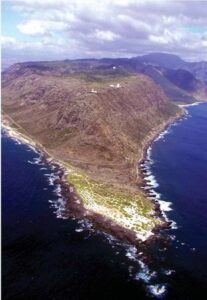In "Partner Perspectives" we get to know the diverse people, roles, and views of wildfire management in the Pacific.
Name: David G. Smith
Role: Administrator
Organization: Division of Forestry and Wildlife (DOFAW), HI Dept. of Land & Natural Resources
Pacific Fire Exchange (PFX): How would you describe your role at the Division of Forestry and Wildlife (DOFAW)?
David (DS): I’m the Forestry and Wildlife Administrator for DOFAW, in an executive position running the organization. My day-to-day is a lot of policy work, reviewing things and pushing stuff forward. I do have many years in the field with DOFAW and I’ve worked at a number of different levels, starting as a professional biologist and spent some time as a forester, so I understand how it works on the ground. Now I get people the tools and resources they need to do their jobs out in the field.
PFX: Can you describe DOFAW's role with fire?
DS: DOFAW is within the Department of Lands and Natural Resources (DLNR), which manages approximately a quarter of the land in the state. We manage a wide range of areas - from really pristine native forest with a very high native component, to grass and brush lands that are pretty much 100% non-native and are managed for game and other uses.
DOFAW has been the pre-eminent wildland fire management organization in Hawaii for many years. We’ve always worked closely with the counties, and especially so after the counties were set up with the incident command system. When we show up on a fire, we do transitions and take the lead. DOFAW is also the lead on many things in terms of pre-suppression, fire awareness and management.
“...here was this tremendous opportunity to go out and replant with natives. Yet we weren’t geared up to do that - there weren’t any resources for it.”
KAENA POINT. SOURCE: DOFAW
PFX: Was there a particular event that sparked your own interest in fire?
DS: Around 2000, there was a fire at Kaena Point on Oahu. The area had been converted into a grass fire matrix with scattered native plants. The fire burned through the grass and scorched a bunch of natives. On the one hand, it was a clean slate. All the introduced grasses had been burned off, and here was this tremendous opportunity to go out and replant it with natives. Yet we weren’t geared up to do that - there weren’t any resources for it. Kaena Point was a real eye-opener of how, one, we need to change the grass-fire regime, and two, we need to get back in and do rehab of burned areas.
PFX: How have things changed in terms of post-fire management since 2000?
DS: Slowly the agency has been realizing that post-fire rehabilitation is a really important piece of the entire fire management picture. Take the Koke’e fire restoration project. It’s an enormous undertaking and something that I think is a model for future work - where we’re able to log large amounts of biomass and timber, and replace it with high value natives - in this case, koa. One of the metrics for success is going to be what kind of forest we end up with in 20 years.
Also, with Koke’e, we learned a lot about how those older, mature, senescent timber stands of eucalyptus behave in fire. Because we know they’re going to burn in such a way, there’s justification for us to do pre-fire clean-up. Instead of waiting for the fires, we could try to do some of the thinning and pre-suppression work that will limit the spread of fires and utilize the resources that would otherwise burn.
“The best management for a lot of species, ecosystems, and landscapes is not just going to be managing to your border.”
PFX: Share an experience you’ve had in partnering with others to meet a fire management goal.
DS: The best management for a lot of species, ecosystems, and landscapes is not just going to be managing to your border. Looking across borders and at landscape-scale management and maintenance is what we’ve really focused on in the last 20 years. As an example, the Waianae Mountains Watershed Partnership (WMWP) on Oahu involves a number of landowners. We’re working across boundaries to look at watershed protection, native forest and native ecosystem protection.
We’ve been able to raise awareness of fire issues and work cooperatively to address them. For instance, WMWP is out in Waianae Kai - where we’ve had a lot of these grass fire issues - and they’re starting to install fuel breaks. We’re figuring out how to restore stream courses, waterways, and drainages to break the area up into manageable chunks, breaking up that grass-fire cycle and starting to put in shade trees.
PFX: Favorite way to spend the weekend?
DS: My favorite way to spend the weekend is paddling outrigger canoes.
PFX: Share something most people don’t know about you.
DS: I am a certified arborist. I climb trees and do tree maintenance on the side. I do consulting, I get paid to trim people’s trees, and I do a lot of volunteer work for community organizations and that kind of thing. It’s fun.

